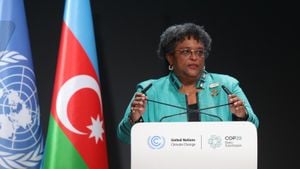The air quality crisis gripping South Asia has reached alarming levels, particularly affecting densely populated cities like Delhi, Lahore, and Multan. With the Air Quality Index (AQI) soaring above 2000, the Punjab government declared health emergencies and lockdowns to manage the hazardous conditions.
Authorities across multiple regions are struggling to combat the health risks posed by weeks of severe smog, driven primarily by pollution from vehicles, agricultural burning, and industrial emissions. To give you some perspective, the AQI hitting 500 signifies 'severe pollution' where even healthy individuals can start to experience serious health effects.
On November 19, 2024, North India witnessed some of the worst air quality yet, prompting the Delhi government to declare medical emergencies. Reports indicated overwhelmed hospitals filled with patients suffering from asthma, pneumonia, and other respiratory conditions.
The situation has been dire for some time. The thick fog mixed with smoke has led to severe visibility issues and public outcry. People have been advised to limit outdoor activities, wear masks, and avoid strenuous exercise.
Senior government officials and health experts have called for urgent measures, arguing for regulatory enforcement surrounding industrial emissions and vehicle pollution. The Director of Climate Trends, Aarti Khosla, emphasized the multifaceted nature of the crisis, explaining why solutions require consideration of various pollution sources, including black carbon and roof runoff from roads.
States neighboring Delhi, like Punjab and Haryana, are also grappling with similar challenges. Local officials reported hospitals being flooded with patients suffering from pollution-related health issues, leading to major personnel strains within healthcare facilities.
The Punjab government's response has been significant, declaring lockdown measures to reduce outdoor activities and thereby limit exposure to the toxic air. Measures became stringent, with closures of schools, restaurants, and non-essential businesses for several days as yet another layer of diagnosis attempts to wrestle control back from the smog disaster.
For cities like Multan and Lahore, the declaration of health emergencies sets off alarms, with more than 600,000 residents experiencing pollution-related health complications. Hospital resources were quickly consumed, forcing OPDs to extend operating hours and redirecting medical staff to areas hardest hit by the pollution crisis.
With public health at stake, one notable response has been the temporary ban on all outdoor dining and the shuttering of wedding halls which have been cited as pollution contributors—part of the government’s commitment to modifying behaviors to bring down emissions.
To really grasp the depth of the crisis, over 60,000 hospitalizations were logged across Punjab due to respiratory illnesses from smog last week alone. Key hospitals reported thousands of new patients presenting with coughing fits and respiratory infections, inundated by those seriously affected by air quality degradation.
Lockdown measures may seem drastic, but the alternative appears graver. Authorities have taken unprecedented steps, including considering artificial rain, but experts indicate those are mere band-aids on the gaping wound created by pollution.
Adding fuel to the fire, Delhi’s toxic smog has become a talking point at the COP29 climate summit. Here, scientists expressed concerns about not only local residents but also the wider climate impact stemming from such pollution levels, urging for decisive action.
Health experts are making waves, too, as they spotlight the necessity for systemic changes, including stricter regulations on vehicle numbers and industrial emissions, which can act as major contributors to the smog issue. Although immediate lockdown solutions provide temporary relief, critics assert the necessity for long-term monitoring and reformations within existing polices to combat air pollution causatively.
Indeed, the discourses surrounding the pollution crisis stretch beyond mere awareness to outright demands for policy mobilization—creating pathways for individuals and organizations to gain traction against recurrent smog threats, elevates the conversation significantly. From health emergencies noted at COP29 to provincial lockdown decisions, it's evident the answer to, "What’s next?" lies within our continuous surveillance over air quality and environmental justice frameworks.
With these issues at play, policymakers must grapple with balancing economic activities with health imperatives. The people of South Asia deserve not only immediate relief but also sustainable strategies moving forward, enhancing quality of life without compromising health or the environment.



